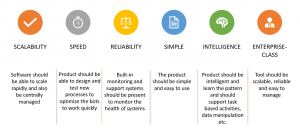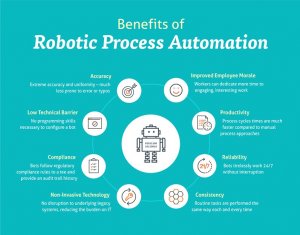Introduction
The Robotic Process Automation (RPA) is a new class of future technology which brings together interdisciplinary knowledge of advanced technologies in computers science, electronic and communications, mechanical engineering, and information technology. It is a combination of hardware, software, networking, and automation which enables performing complex tasks in a simple and reliable way. The term “Robotic Process Automation” imply visions of physical robots wandering around offices performing human tasks, the term really means automation of service tasks that were previously performed by humans. For business processes, the term RPA refers to configuring a software to perform tasks which were previously carried by people (for instance, transferring data from multiple input sources like email and spreadsheets to systems of record like Enterprise Resource Planning (ERP) and Customer Relationship Management (CRM) systems). The added advantage of robot process automation technology is that even non-technical employees will have the tools available to configure their own software robots to solve automation challenges. RPA can bring immediate value to the core business processes including payroll, employee status changes, new hire recruitment and on boarding, accounts receivable and accounts payable, invoice processing, inventory management, report creation, software installations, data migration, and vendor on boarding etc.
Benefits of RPA
Some of the benefits of Robotic Process Automation are as below,
RPA Tools
Robotic Process Automation (RPA) Tools are widely used for the configuration of task automation. There are numerous RPA tools available in the market and choosing one could be a challenge. Given below is a list of the most popular RPA tools. The list contains both open source(free) and commercial(paid) software.
1: Blue Prism
Blue Prism can work on any platform with any application. This tool helps business operation to be agile and cost effective by automating, manual, rule-based back repetitive office processes. The tool provides a flow chart like a designer with drag and drops feature to automate various business processes. This is perfect for medium and large organizations.
Features:
- It supports multi-environment deployment model.
- Security provided for network and software credentials.
- Build highly efficient and automated end-to-end business processes.
- It can be used on any platform and can work for any application.
- High-speed execution.
- Easily implemented in the short time span of 4 to 6 weeks.
- Robust and feature-rich analytics suite.
- Improved Control Room to offer real-time feedback.
2: UiPath
UiPath is a highly extensible Robotic Process Automation (RPA) tool for automating any desktop or web apps. UiPath provides all core capabilities. It allows global enterprises to design, deploy a robotic workforce for their organization. It is user-friendly for non-developers too. It can handle complex processes. And this tool is perfect for any size of business.
Features:
- UiPath can be hosted in virtual terminals or cloud environments.
- Provide support for a high range of applications to work with, which includes web and desktop applications.
- Auto-login features to run the bots.
- Scraping solution which works with .Net, Java, Flash, PDF, Legacy, SAP, with absolute accuracy.
- It provides security by managing credentials, providing encryption and access controls based on the role.
- It can automate faster. Eight to ten times faster automation through Citrix too.
- It provides an open platform and free of cost.
- It can handle any process, in any number, irrespective of its complexity.
- No programming skills required.
- Ease of use through drag and drop facility.
3: Automation anywhere
Automation Anywhere RPA developer tool combines conventional RPA with intellectual elements like language understanding and reading any unstructured data. It provides all core capabilities and cloud services. This user-friendly is perfect for medium and large organizations.
Features:
- Intelligent automation for business and IT operations.
- Uses SMART Automation Technology.
- Rapidly Automates complex and complicated tasks.
- Distribute tasks to multiple computers and offers script less automation.
- Provides security through authentication, encryption, and credentials.
- Real-time reports and analytics.
- Provides platform independence and user-friendliness.
4: Pega
Pega systems automation framework tool supports all usage scenarios. Pega unifies architecture based on a business rule management system and predictive analytics decision management mechanism. It can be used on desktop servers. It provides only cloud-based solutions or services. It can work on Windows, Linux, and Mac. This tool is perfect for medium and large businesses.
Features:
- Open APIs that quickly connect to your existing services.
- Actionable intelligence helps you to automatically finds processes to optimize.
- Captures insights at the desktop. It gets complete details of how work gets done.
- It will help you in the deployment of your solutions to the customers.
- It provides a cloud-based solution.
- It doesn’t store any execution data in a database, rather everything gets stored in the memory.
- With this tool, you can distribute the work to desktop, server, and employees as well.
Factors to look in RPA Software
Below are the factors, you need to consider while choosing a RPA software.

Case Study
The RPA technology can be applied in multiple sectors to improve the process efficiency with significant cost reduction. These sectors include customer service and support desk, IT and infrastructure support, data migration and management, digital and online initiatives and back office administration.
The availability and accessibility of information creates “big data”, which is becoming bigger and bigger day by day. Though this data is very valuable, it is getting tougher and more time consuming to manage, measure and analyze it in a reliable way. With this increasing amount of data available, manual processes and human intervention leave greater margin for error and lengthier processing time. Implementing RPA to automate these high-volume low complexity tasks can ensure optimal resource utilization, reducing chances of human error and easier integration with customer/supplier electronic portal.
Consider an example of adding or updating contact details in Salesforce. The bots can be set up to read emails and identify if the email is to add or modify a contact. Once it is identified, the data is accumulated in Excel. Bots are then set to perform the task of logging in to Salesforce and enter the contact details that are stored in Excel. So, whenever an email comes in that requires updating of contact, this RPA process is triggered and requires no manual intervention to add/modify contacts. A company with a big customer base can receive hundreds of emails every day to update contacts. Every time manually updating the data takes a lot of man hours. Using RPA, we can make this process easy and fast.
Summary
Robots and Robotic Process Automation technologies are becoming an integral part of business operations to sustain in highly competitive business environment. The implementation of RPA tools will definitely create value in an organization by reducing the cost, improving the process efficiency and will enable optimal utilization of manpower. In near future, we will see machines taking a more active role in enhancing human endeavours and renovating the customer experience with RPA will become a digital priority.
Contact us at sales@brainbox.consulting for more information and we would be happy to assist you with testing related services.



